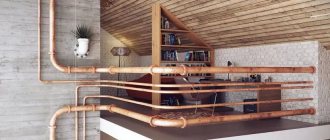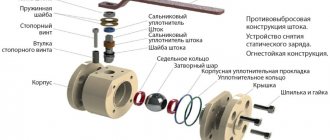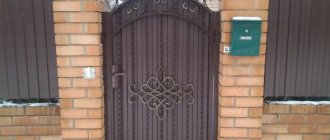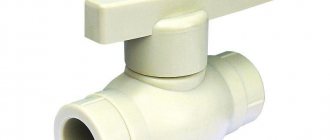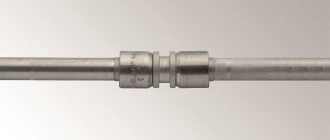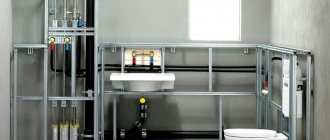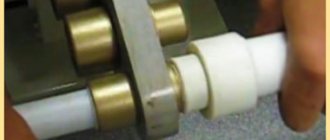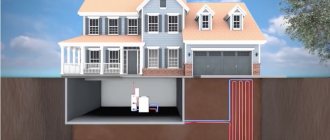In some kitchens, part of the space belongs to the ventilation duct. It becomes a problem when developing a design. It is important to take into account all the nuances in order to beat this circumstance profitably. The design of a kitchen with a ventilation duct involves many features. Useful recommendations will help you create a beautiful interior.
In almost all apartments, the kitchen is a small room, so every meter counts.
And how lost apartment owners are when they discover that part of the usable area where food should be prepared is occupied by a ventilation duct.
- 1 What types of ventilation ducts are there?
- 2 Kitchen design with a ventilation duct: correct camouflage of the necessary detail
- 3 Correct and asymmetrical shape of the ventilation duct: design secrets
- 4 Features of developing a kitchen design with a ventilation duct
- 5 Ways to disguise a ventilation duct
- 6 Masking the box using simple materials
- 7 Options for involving the ventilation duct in the overall kitchen interior design
- 8 New design trends
- 9 Disadvantages: solutions
- 10 Recommendations and nuances for planning
- 11 Protrusion of the box for the false fireplace
- 12 VIDEO: Kitchen design with a ventilation duct.
- 13 50 kitchen design ideas with a ventilation duct: 13.1 See also
What types of ventilation ducts are there?
The box may have modest dimensions and take up little space. Or have a large size, which causes a lot of inconvenience. It is important that the structure cannot be dismantled for safety reasons. The box can be located in a corner or at the entrance. Most of them are rectangular in shape.
The presence of such a detail confuses many people, because it does not allow the use of headsets created for a standard layout and the implementation of many ideas.
The design of a kitchen with a ventilation duct requires a special approach and a non-standard solution to the problem of an unsuccessful layout.
See also Original design techniques for a kitchen with a window, photo.
Creating a dome for an exhaust device
On the plinth running along the top of the pedestal of the dome structure being erected, pieces of platband should be attached, performing the functions of baguettes. In order for a homemade kitchen hood to have a flat board, it should be trimmed around the perimeter using a planer. It is also worth noting that the upper end must be processed parallel to the opposite one. After similar sawing, carried out at an angle, it can be adjusted to the location.
As a result, the dome will be raised from the base. Templates must be made from fiberboard according to the form. As for their ends, they should create a frame intended for hardboard. It is from this that the walls of the dome structure will be made. For the purpose of fastening we use glue. Regarding fiberboard profiles, they can be fastened in various ways, among which we highlight the following:
It is also worth noting that the dome frame must be nailed to the base. It should also be remembered that the very bottom of the profiles will not be visible. In this case, you can lay the platbands horizontally. After finishing cutting the platbands and skirting boards, you can proceed to varnishing them.
We install the hood itself as usual. After this, a dome is erected on top, within which there is even a small shelf. It, in turn, can be decorated with an environment of carved railings. As you can see, making a kitchen hood yourself is not that difficult.
Source
Kitchen design with a ventilation duct: proper camouflage of the necessary detail
To organize competent camouflage, you should take into account the tips.
- Use putty to level the structure. Then paint it and the ceiling in the same tone.
- It is better not to disguise, but to increase functionality. You can turn the box into a TV stand. Having played favorably, you can get an additional location for the equipment.
- Integrate into furniture. This will hide everything from view and will not require any decorating techniques.
The main task when creating a kitchen interior is to turn what initially seems like an unnecessary structure into a useful thing.
A ventilation duct can become not only functional, but also the main detail in the kitchen and its decoration.
See also Corner cabinet for kitchen sink
Rules for choosing the duct cross-section
Air ducts are made of plastic and aluminum, corrugated and round. Rectangular designs look harmonious against the background of rectangular cabinets.
Round ducts are more efficient because there is less resistance to air flow. Corrugated pipes are soft, easy to bend at any angle and weightless.
They do not insulate noise well and, having a ribbed structure on the inner surface, quickly become dirty. During installation, it is recommended to stretch the folds of the corrugation as much as possible in order to reduce the relief for dirt accumulation.
To obtain the result of good cleaning and fresh air flow, and also to ensure that the air duct operates without interruption and noise, it is necessary to calculate the dimensions and diameter of the air duct.
The diameter of this structure should match or be slightly larger than the diameter for the outlet at the hood. A smaller diameter reduces throughput and operating efficiency, as the resistance of the air being passed through increases.
The power of the hood used is also reduced. When installing the air duct, you cannot plan sharp corners or 90° angles. To prevent air from returning, a check valve must be installed.
Ventilation ducts should be located above the cooking surfaces. The length of the air exhaust pipes is provided for no more than 3 meters.
To ensure maximum use of the hood and to work correctly, the distance between the stove and the hood is kept no more than 75 cm.
When choosing hoods for the kitchen and boxes for decoration, you need to rely on technical parameters, the size of the kitchen, personal preference, and financial situation. Also study the characteristics of materials and their functionality.
Taking into account all the points, you can choose suitable hood options for your kitchen. Buy a box or make it yourself to hide bulky and ugly parts of the air duct. And your kitchen will take on an individual, stylish look.
Correct and asymmetrical shape of the ventilation duct: design secrets
When implementing a kitchen design with a ventilation duct, it is important to consider its shape. Descriptions of the species are shown in the table.
Before you start renovating and developing a kitchen design with a box, you need to study all the features of this item.
Typically, there are two types of ventilation ducts in rooms.
| Form | Description |
| Rectangular | Mosaics and tiles that completely match the overall interior are suitable for decoration. A work surface is installed on each side. A complete image emerges. |
| Incorrect | Shape the rectangle yourself using the casing. The latter can be created from plywood or drywall. For decoration, choose attractive materials such as bricks and tiles. |
See alsoKitchen 8 square meters, ideas for the kitchen
Features of developing a kitchen design with a ventilation duct
The design of a kitchen with a ventilation duct requires taking into account the layout of the room. Draw the project on paper. This will help identify problem areas, complete them, and eliminate controversial nuances. Remember safety. So, when located next to a gas stove box, vinyl siding will not be suitable for finishing. Otherwise, the risk of fire will increase. If there is a sink nearby, discard the wallpaper.
Some boxes have small dimensions: less than sixty centimeters in width and depth.
Others cause a lot of inconvenience, since the huge size of the structure attracts attention.
See alsoKitchen design 13 square meters
Several placement rules
Since there is nothing complicated in the hood installation scheme, many homeowners prefer to do the installation themselves. It is worth knowing that:
- the distance to the gas stove should be 75-85 cm for a straight line, and 55-65 cm for an inclined one;
- for an electric stove the figures are slightly less than 65-75 cm and 35-45 cm, respectively;
- there must be a socket above the wall cabinet;
- Grounding is required.
You can deviate from the standards by 5-10 cm only if the design features or height of the cook do not allow it.
Methods for masking a ventilation duct
There are several methods of effective camouflage. The most harmonious and popular is integration into furniture. Elements are made to order, which will require increased financial investment. But after all the work has been done, it will be difficult to guess that the box is present in the room.
It is difficult to enclose such an element discreetly, and the situation is further complicated by the fact that not all ventilation protrusions are rectangular in shape.
Much depends on the location of the structure. If there is a slight protrusion, you can install a cabinet in front of it. If the box is at the top, choose a hanging model for it.
The most common layout option: a kitchen with a ventilation duct in the corner. Usually all communications are located in the same place.
You can make shelves on the structure to place kitchen items. If you fix the bracket, then there will be a place for the TV.
It is more difficult to disguise a box that is located along the wall and is located almost at the very entrance to the kitchen.
See alsoKitchen renovation, interior design and decoration
Kitchen ventilation systems: natural or forced
Not everyone knows which ventilation scheme for the kitchen is better: standard natural, when exhaust gases exit through a duct to the street, or forced (a fan is used to remove contaminated oxygen). There is no definite answer to this question, because each of the hoods performs its own functions and has its own advantages and disadvantages.
In the kitchen, regardless of its location (in an apartment or a private house), the presence of a natural ventilation system is mandatory. Particular importance should be paid to the performance of the equipment, and especially if there is a gas stove in the room. In this case, harmful emissions will be discharged through a vertical natural ventilation channel. The exhaust rules do not consider forced ventilation to be a mandatory engineering service; it only ensures the comfort of residents. Next, we will describe each type of air exchange in more detail, consider their strengths and weaknesses.
Natural ventilation in the kitchen
Exhaust ventilation in the kitchen is familiar to all residents from vertical shafts that have an exit on the roof of a residential building. Harmful substances and fumes are removed through such passages, and fresh air enters the premises through cracks in the windows or special valves on the frames. Warm air heated by the kitchen stove tends to rise, it accumulates on the ceiling and goes through the ventilation hole outside the house. In its place, fresh oxygen comes from the street.
Proper, high-quality ventilation for the kitchen in an apartment removes a small amount of waste gas, but does this in a constant mode. A ventilation duct cleared of debris is capable of removing carbon monoxide and minor fuel leaks from kitchen equipment. To effectively remove foreign odors, a hood must be mounted above the stove.
Supply ventilation has the following advantages:
- high-quality air exchange in the apartment;
- removal of harmful substances that are released during cooking;
- removal of odors and high air humidity when several burners are turned on;
- lack of financial investments for the operation of the system;
- noiselessness.
Ventilation in the kitchen with a hood has the following disadvantages:
- decreased performance in hot weather;
- the possibility of air return from the street into the kitchen;
- relatively small volume of processed air per unit of time;
- you need to constantly check the draft in the ventilation duct.
Not all owners of country property know how to properly install a natural ventilation system in a private home. In this case, the channels will be made in the walls of utility rooms, such as the bathroom, toilet and kitchen. For high-quality ventilation of the entire house, and not just these rooms, it is necessary to additionally let in air flow from the bedroom, living room or dining room. In some cases, you need to keep the windows open.
If a four-burner gas stove is installed in the kitchen, then the hourly volume of processed air should be within 90 m3. For efficient operation of the ventilation system, it is necessary to install a channel with a cross-section of 0.02 m2. This parameter corresponds to a pipe diameter of 16 centimeters or a shaft made of brick in the shape of a square with a side size of 14 centimeters. The entrance to the channel is located on the ceiling or at a distance of 20-30 centimeters from it. To ensure stable draft, a ventilation duct of at least 5 meters in length is needed.
Forced exhaust system
The term forced ventilation refers to an engineering system in which contaminated air flows are removed outside using a fan. In the kitchen, such devices are installed using different methods:
- In the vertical ventilation shaft.
- In a hole made in the wall of a building. In this case, the polluted air will be discharged from the kitchen outside, bypassing the ventilation shafts.
- A corrugated pipe from a kitchen hood can be inserted into a window.
- Some consumers install a special device, a hood, above the gas stove. Polluted air can escape from the kitchen into natural ventilation shafts or directly into the street through a hole in the wall.
The advantages of connecting an exhaust fan or kitchen hood are:
- Improved performance. Effective ventilation in the kitchen allows you to quickly remove odors and harmful substances accumulated in the air.
- A kitchen hood above the stove removes harmful substances before they enter the room.
The disadvantages of the hood device are:
- Dirty air is removed from the room only when the fan is running.
- Such a system requires financial investment. In addition to the cost of the hood itself, you will have to constantly pay for the electricity consumed.
When installing a fan in a shaft, there are several important points to consider. The fact is that such a device has a check valve that prevents the suction of dirty air when the hood is not working. This valve must be removed so that it does not interfere with the operation of the natural air exhaust system. It should be noted that the performance of the device will coincide with the passport data only if a horizontal outlet channel of short length is installed. A modern hood connected to a common house shaft will have lower productivity compared to the declared technical characteristics. Ventilation diagram in the kitchen with a hood
Masking the box using simple materials
The following materials can be used for camouflage.
- Slate. Suitable for modern design. Helps create a key focal point in the room.
- Mirrors. Relevant for a small kitchen. The mirror surface allows you to visually increase the dimensions.
- Mosaic. Allows you to turn a problematic design into an attractive highlight of the kitchen. By choosing metal mosaic details, you can fit it into a loft or hi-tech style.
- Tile. Allows you to create an attractive appearance. A combination of light and dark squares is especially preferable.
It is prohibited to dismantle the box, because any damage to the ventilation system can lead to serious consequences.
In some rooms, it is possible to reduce the ventilation duct, but to do this, you must first obtain a diagram of the home’s ventilation system from the housing organization, and then seek help from specialists.
See also: What mistakes should you avoid in designing and choosing the style of a winter garden?
Kitchen hood decor - photo
© Galina SHINKAREVA, Moscow Photo by the author
TOOLS FOR CRAFTSMAN AND CRAFTSMAN, AND HOUSEHOLD GOODS VERY CHEAP. FREE SHIPPING. THERE ARE REVIEWS.
Subscribe to updates in our groups and share.
Let's be friends!
1 Comment
Cleaning and refreshing the hood My mother used this method, and now I have adopted it. 1. Before cleaning, be sure to unplug the hood and remove the filter. I pre-soak all the separated parts in water with the addition of an anti-grease agent, and then wash them with a brush or sponge and pour boiling water over them. 2. I cut two lemons in half. I rub the surface of the hood and filters with the pulp. Leave for 15-20 minutes to dissolve the remaining fat. I wipe with a damp cloth. Note: You can now find advice on the Internet where it is recommended to boil filters. But it’s better not to do this: after boiling, the spare parts become deformed and subsequently either cannot be installed in place or fall out.
Options for involving the ventilation duct in the overall kitchen interior design
The ventilation duct can be included in the overall style as follows.
- Build several niches where lighting or contrasting finishing materials are mounted.
- Install several paintings, turning this island into a miniature art gallery. Photo wallpaper will also work.
- Hang a board with chalk where you can leave messages and draw.
In fact, the box is a very important element, because it allows the odors that arise as a result of cooking to evaporate from the apartment faster.
Before it becomes clear what can be done with the ventilation duct, you will have to study the features of the layout of the kitchen space
See alsoCountry style kitchen design in a city apartment
Hood as a basic functional attribute of kitchen premises
It’s hard not to agree that no matter how high-quality materials and expensive repairs are made, everything is useless if you don’t take care of it.
Kitchen care is the main function of the hood. When cooking on an electric or gas stove, various vapors are released, which subsequently remain on all surfaces in the form of soot.
In addition, the unit acts as a remover of foreign odors, which also contributes to a favorable environment in the apartment.
When you open a window, the smell goes deep into the room and is eliminated over time when mixed with new air masses, but the technology allows you to draw out odors immediately, preventing them from spreading throughout the rooms.
The hood contributes to a favorable atmosphere and cleanliness in the kitchen
New Design Trends
By hanging cabinets in rich colors, you can divert attention from the shortcomings of the room. To even out the area, choose floor coverings with a geometric pattern. To increase the size of the kitchen, you can connect it to the living room. More space will appear, the box will become less noticeable. If the structure is too large, then you should abandon design techniques for camouflage. It is better to divide the work surface into several sections.
The ventilation protrusion can be disguised in several ways. But most often, designers hide it under the elements of the kitchen set.
In this case, the furniture will be made to order, which, of course, will require large investments.
See also: How to clean a new refrigerator before turning it on for the first time. Folk remedies and household chemicals
Let's summarize or the latest tips on selecting materials
Option for decorating the ventilation duct - various tiles
When purchasing materials for a box, you must take into account all the characteristics, advantages and disadvantages of the selected product. For example, to make a box for a kitchen hood, you can use wood, plastic, plasterboard, aluminum, steel, chipboard, MDF. The box located in the kitchen will be exposed to vapors and drops of fat that settle on any kitchen surface in the kitchen. Therefore, it will have to be cleaned regularly using household chemicals. The material must be resistant to moisture and temperature changes.
Even at the stage of drawing up the project, it is necessary to make a choice. Whether it will be part of the kitchen set or will naturally fit into the interior - everything is decided individually, taking into account the layout. The main thing is that the projection of the air duct is designed not only beautifully, but also in accordance with generally accepted technical requirements.
Inconveniences: solutions
To solve the inconvenience caused by the box, you can use the following solutions.
- Enhance everything with built-in wall cabinet shelves. Make cladding with various materials.
- Disguise using a manufactured headset. Suitable only for rooms larger than 10 square meters. m. At the site where the structure is mounted, you can install a floor cabinet equipped with open shelves.
when specialists take the necessary measurements, manufacture and install cabinets, no one will even guess about the existence of an “extra” element in the kitchen.
In cases where the box is located in the corner and the kitchen is quite large, you can buy ready-made furniture, namely a set that is installed in the shape of the letter “G” or “L”.
See also Quartz countertop: manufacturing features, examples and tips
Recommendations and nuances for planning
A preliminary measurement of the entire room is carried out. The future design must be embodied on paper in detail. It is important to take into account the type of ventilation duct, its dimensions and shape. The place where it is located is also important. This will help you decide on a style.
The box can be hidden under a floor cabinet that has open shelves.
If the box protrudes only a little, then an ordinary cabinet can be placed in front of it. If the box is located at the top, you will have to find a suitable wall cabinet.
See also: Making your own Provence style curtains for the kitchen
Varnishing process
Any kitchen hood made by yourself requires varnishing, and for these purposes you should choose a varnish that is distinguished by its heat resistance. There are the simplest requirements for this substance:
If the varnish meets these requirements, then you can safely use it. The boards must be prepared in advance. This kind of preparation means, first of all, drying them. For these purposes, you can use the method of hanging above the stove. Then, when the material has dried, you can proceed to sawing.
First you need to apply a primer, the purpose of which is to provide reliable protection against insects and rotting processes. Next comes the stain. Then we prepare a mixture of varnish and solvent in a ratio of one to four. After priming, it is necessary to coat the wooden surface with this solution. In this case, the varnish will sit well and the possibility of peeling off the bottom layer will be eliminated.
Next, you need to wait until everything is completely dry. To speed up the drying process, various special means can be used. They are really worth using, since the varnish itself requires about five layers. Of course, everything must dry and be polished.
Extension of the box for a false fireplace
One of the finishing options is the implementation of a false fireplace. This is one of the simpler but more beautiful solutions to the problem. In other cases, it will be necessary to expand the space to create an additional approach. A false fireplace will add coziness and warmth to the atmosphere of the kitchen.
There are a number of other ways that a ventilation duct can become a useful element.
This is not only an excellent disguise, but also a very beautiful solution that enlivens and ennobles the interior.
See alsoPistachio-colored cuisine: fresh, extraordinary, positive
